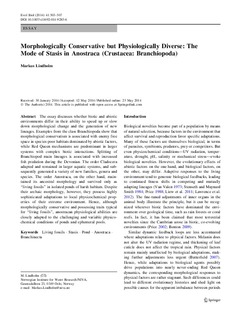| dc.contributor.author | Lindholm, Markus | |
| dc.date.accessioned | 2018-09-13T10:55:26Z | |
| dc.date.available | 2018-09-13T10:55:26Z | |
| dc.date.created | 2014-12-06T12:46:48Z | |
| dc.date.issued | 2014 | |
| dc.identifier.citation | Evolutionary biology. 2014, 41 (3), 503-507. | nb_NO |
| dc.identifier.issn | 0071-3260 | |
| dc.identifier.uri | http://hdl.handle.net/11250/2562484 | |
| dc.description.abstract | The essay discusses whether biotic and abiotic environments differ in their ability to speed up or slow down morphological change and the generation of new lineages. Examples from the class Branchiopoda show that morphological conservatism is associated with enemy free space in species-poor habitats dominated by abiotic factors, while Red Queen mechanisms are predominant in larger systems with complex biotic interactions. Splitting of Branchiopod main lineages is associated with increased fish predation during the Devonian. The order Cladocera adapted and remained in larger aquatic systems, and subsequently generated a variety of new families, genera and species. The order Anostraca, on the other hand, maintained its ancestral morphology and survived only as “living fossils” in isolated ponds of harsh habitats. Despite their archaic morphology, however, they possess highly sophisticated adaptations to local physicochemical properties of their extreme environment. Hence, although morphologically conservative and possessing traits typical for “living fossils”, anostracan physiological abilities are closely adapted to the challenging and variable physicochemical conditions of ponds and ephemeral pools. | nb_NO |
| dc.language.iso | eng | nb_NO |
| dc.publisher | Springer Verlag | nb_NO |
| dc.relation.uri | http://link.springer.com/article/10.1007%2Fs11692-014-9283-6 | |
| dc.rights | Navngivelse 4.0 Internasjonal | * |
| dc.rights.uri | http://creativecommons.org/licenses/by/4.0/deed.no | * |
| dc.title | Morphologically Conservative but Physiologically Diverse: The Mode of Stasis in Anostraca (Crustacea: Branchiopoda) | nb_NO |
| dc.title.alternative | Morphologically Conservative but Physiologically Diverse: The Mode of Stasis in Anostraca (Crustacea: Branchiopoda) | nb_NO |
| dc.type | Journal article | nb_NO |
| dc.type | Peer reviewed | nb_NO |
| dc.description.version | publishedVersion | nb_NO |
| dc.rights.holder | The Author(s) 2014 | nb_NO |
| dc.source.pagenumber | 503-507 | nb_NO |
| dc.source.volume | 41 | nb_NO |
| dc.source.journal | Evolutionary biology | nb_NO |
| dc.source.issue | 3 | nb_NO |
| dc.identifier.doi | 10.1007/s11692-014-9283-6 | |
| dc.identifier.cristin | 1181640 | |
| dc.relation.project | Norges forskningsråd: 208279 | nb_NO |
| cristin.unitcode | 7464,30,19,0 | |
| cristin.unitname | Ferskvannsøkologi | |
| cristin.ispublished | true | |
| cristin.fulltext | original | |
| cristin.qualitycode | 1 | |

